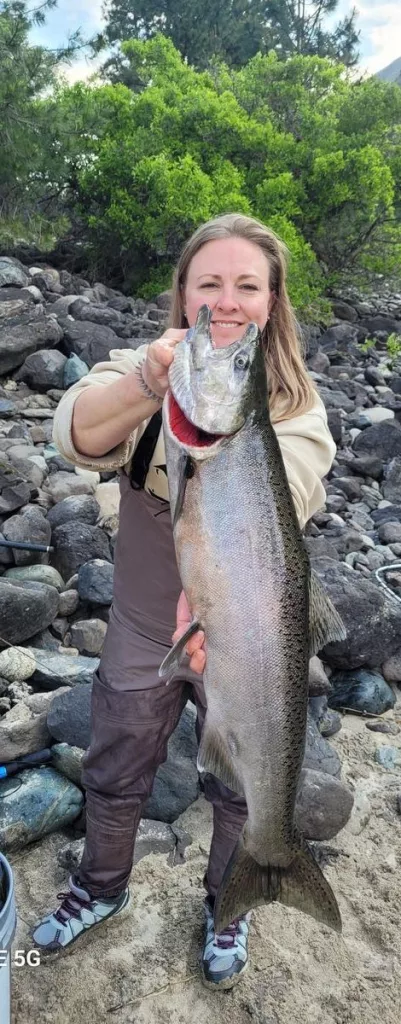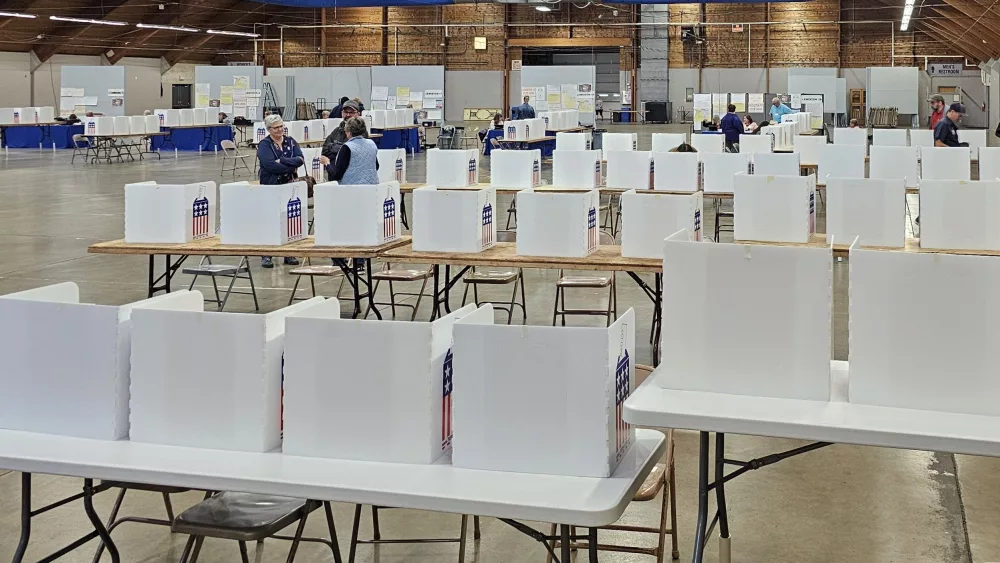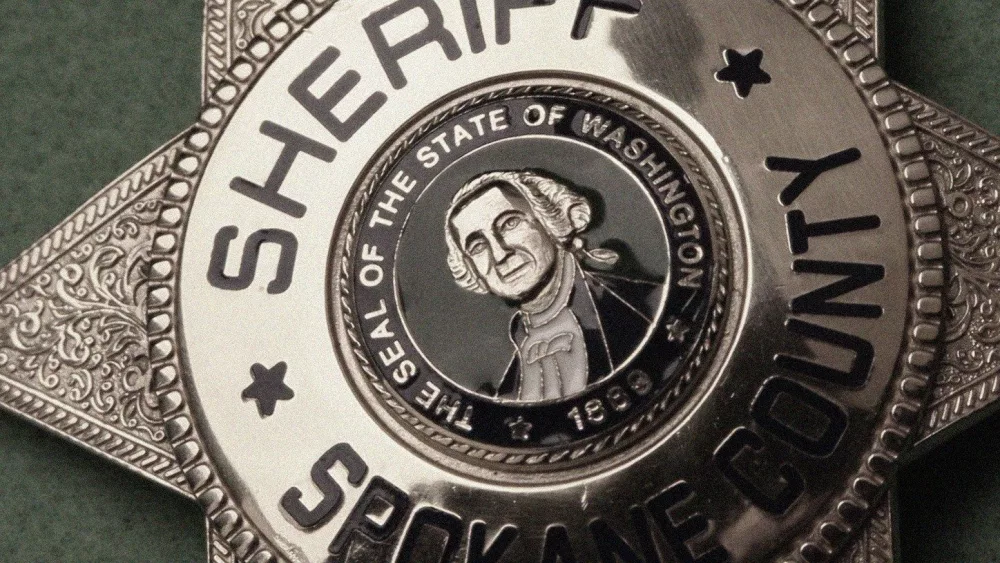Run Status
Fall Chinook Salmon passage over Bonneville Dam is nearing completion (about 90% complete), and as such, we have a good understanding of how many fish bound for the Snake River basin will return from the ocean this year. It looks like this year’s return past Bonneville Dam will be about 36,000 adult fish which is lower than the preseason forecast (about 47,000 fish). Regardless, this size of return is large enough to provide some exciting fishing opportunities.
A troubling issue we are seeing this year is the fall Chinook Salmon are taking longer to migrate to Lower Granite Dam than has occurred in the past. This is troubling because the slower these fish migrate the fewer that tend to make it to Idaho. Most suspect this slow migration is due to the warm water temperatures occurring in the Columbia and Snake rivers. At this point, we don’t know how many fall Chinook Salmon will make it to Idaho, but in years when we saw slower travel times, survival rates during their migration from Bonneville Dam to Lower Granite Dam approached 50%. This year the migration rates are the slowest we have seen since we started PIT tagging these fish. As such, we fear their survival rate could even be less than 50%. If we assume the survival rate this year will be 48%, about 24,000 adult fall Chinook Salmon would make it to Lower Granite Dam (see 2025 bar in figure below). If this survival rate is accurate, it would come in considerably below the 10-year average (34,000 adult fish). Additionally, the adult wild return to Lower Granite Dam would be around 4,700 fish which is the lowest we have seen since 2009 (see figure below).

The number of adult wild fall Chinook Salmon that can be killed during our sport fisheries (through harvest and catch-and-release fishing) is determine by the number of fish that pass over Lower Granite Dam. A sliding scale was developed in coordination with NOAA fisheries that limits harvest of wild fish on down run years and provides more harvest when the wild run is better. One of the important points on this sliding scale is 5,040 adult wild fish. When more than 5,040 adult wild fish pass over Lower Granite Dam, the sport fisheries can kill over 10% of the run. When the adult wild return is less than 5,040 fish, the sport fisheries can only kill 6% of them. In the past, when the adult wild returns over Lower Granite Dam were greater than 5,040 fish, the sport fishery did not reach its allowable wild fish impacts and no changes to the fishing seasons were required. When the return was below 5,040 fish, it was necessary to shut down harvest of adult fish with an adipose fin to protect the wild fish. If survival rates come in similar to what we are projecting, the number of wild fish that pass over Lower Granite Dam will be less than 5,040 fish, and it is highly likely that changes to the fishing regulations will occur that would prevent the harvest of adult fish with an adipose fin. Our goal will be to make this closure at a time when enough impact remains to keep a harvest fishery open for fish with a clipped adipose fin and still incorporate the catch-and-release mortality that will occur on wild fish. It’s difficult to determine if/when this will occur, but if our projection is accurate, I suspect it will occur sometime in September. We will try to give you two to three days’ notice if this change is necessary.
TRAPPING BROODSTOCK AT LOWER GRANITE DAM
The fall Chinook Salmon hatchery program has played a key role in why fall Chinook Salmon returns to the Snake River basin have improved dramatically since the 1980’s and 1990’s. Three hatcheries rear and release fall Chinook Salmon in the Snake River basin. Their overall goal in the past has been to release 5.65 million smolts into the Snake River basin with about 80% of these fish being released upstream of Lower Granite Dam. The broodstock for this program is collected at a fish trap located on Lower Granite Dam’s fish ladder. These fish are trapped in a manner to help meet broodstock goals and reduce handling of wild steelhead. Marika Dobos recently wrote an article about this years trapping protocol at Lower Granite Dam and can be read be clicking on this link: https://idfg.idaho.gov/article/lower-granite-dam-counts-say-one-thing-catching-says-another-fall-chinook-report.
Fishing Boundary Waters
One popular area to fish for fall Chinook Salmon is around the confluence of the Snake and Clearwater rivers (see map below). Where it can get complicated is for those people who have both an Idaho and Washington fishing license and fish in Washington only waters, boundary waters, and Idaho only waters. For those of you who like to do this, you should be aware of the following things. When fishing the boundary water, you can only exercise the privileges of one license at the same time. For example, if you are fishing with two rods (Idaho allows this if you have a two-pole permit, Washington does not allow this) in the boundary water, you must tag your fish on an Idaho permit. You also must follow all other Idaho regulations such as in Idaho whoever hooks the fish must tag the fish (in Washington whoever lands the fish must tag the fish). In addition, if you fish the boundary water, you are entitled to have in possession only the limit allowed by one license regardless of the number of licenses in possession.

If you plan to fish in both boundary waters and Washington only waters, I urge you to call up the WDFW (WDFW Contact Info) to understand how they will enforce various scenarios. I copied the following wording from Washington’s regulations that anglers may not be aware of. “Before utilizing a Washington fishing license or fishing Washington only waters, any fish retained while using another state’s license must be returned to shore before continuing to angle.” In other words, don’t catch a fish in the boundary water and tag it on an Idaho permit and then continue into Washington only waters with that fish in your boat.
KNOW YOUR FISH
If you plan to fish for fall Chinook Salmon you may also encounter steelhead, Coho Salmon, or Sockeye Salmon. They all have different regulations, so it is imperative that you be able to differentiate between them. Be aware that anglers have been catching Sockeye Salmon this year, and there is no season on them anywhere upstream of the mouth of the Snake River. There are many different sources that will help you identify the differences between these species. I have provided links below to some of the better sites.
- https://idfg.idaho.gov/fish/identification/salmon-steelhead
- ‘Spotting’ Salmonids: Put your fish ID skills to the test! | Idaho Fish and Game
- https://wdfw.wa.gov/sites/default/files/publications/01384/2012-13_marine.pdf
- https://www.adfg.alaska.gov/static/regulations/fishregulations/PDFs/southeast/2019se_sfregs_salmon_id.pdf
- https://www.pac.dfo-mpo.gc.ca/fm-gp/rec/identify-identifier-eng.html





